Dec-20-05
 | | Honza Cervenka: It is not easy to see why Tal resigned here but in fact the position was already very bad for him. For example, 23...fxe4 24.Bxe4 Ra7 (or 24...Qd8 25.d6 Nc6 26.Qh7+ Kf7 27.Rfe1 Ra7 28.Bd5+ Kf6 29.Rxc3 Nd4 30.Qe4  with decisive attack.) 25.d6! Nc6 26.Qh7+ Kf7 27.Bd5 Kf6 (27...Be6? 28.Qf5+ with decisive attack.) 25.d6! Nc6 26.Qh7+ Kf7 27.Bd5 Kf6 (27...Be6? 28.Qf5+  ) 28.Qg8 is not viable for black. But maybe 23...Qd8 25.e5 Qe8 was worth to try although the advantage of white is undisputable. It is no wonder that especially Tal was not eager to play it any longer. ) 28.Qg8 is not viable for black. But maybe 23...Qd8 25.e5 Qe8 was worth to try although the advantage of white is undisputable. It is no wonder that especially Tal was not eager to play it any longer. |
|
| Dec-03-11 | | lentin: I think this game record is WRONG. According to M. Tal's "The Life and Games of Mikhail Tal", page 397, Tal mentioned that this game was drawn at white's 31st move. The book only shows a position at black's 28th move and the rest moves. By the way, Fritz 6 shows that even after the moves on the book White is winning. So, maybe there was a time-trouble? |
|
| Apr-05-13 | | ughaibu: Well, look at this: Savon vs Tal, 1970 |
|
Apr-10-13
 | | AylerKupp: Initial Position (Part 1 of 4)
I'm surprised that no one has yet commented on this game. It is insane. I do not think that it is humanly possible to correctly evaluate the final position OTB:

click for larger viewIn "Life and Times of Mikhail Tal" Tal refers to the game only as being "of interest" (!) but after 31.fxg5 he simply says "Drawn" with no further explanation or analysis. Tal gave 30.f4 a "?!", suggesting instead 31.Rxc3!? (Tal's assessment, not mine).
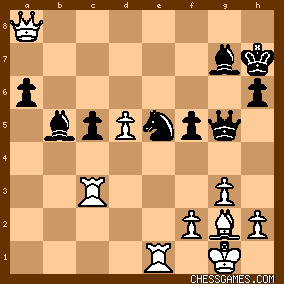
click for larger viewIn that case the following line could be possible, evaluated by Critter 1.6a at [+6.35], d=25, and with the evals increasing: 31...Ng4 32.Rc2 Bd3 33.Ra2 Qf6 34.Rd1 c4 35.Qxa6 Ne5 (I would think that Black has to avoid the exchange of queens by something like 35...Qd4 or 35...Qc3, for example) 36.Qxf6 Bxf6 37.d6 Kg6 38.Ra3 h5 39.Bd5 h4 40.Kg2 h3+ (why just give up the pawn?) 41.Kxh3
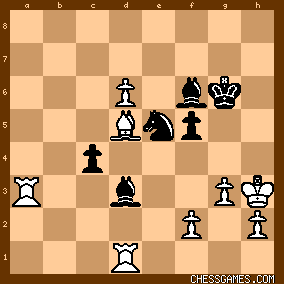
click for larger viewBlack is clearly lost, two exchanges and two pawns down, with an advanced passed pawn of its own. I don't understand the purpose of 38...h5-h4-h3+; maybe Critter just couldn't come up with any reasonably good moves! And, sliding forward, Critter at low ply (d=21) evaluated 35...Ne5 at [+6.92] as Black's best move given the circumstances, and making no attempt to avoid the exchange of queens. So that path apparently doesn't hold any hope of salvation for Black either. So Tal was apparently correct in his assessment of 31.Rxc3!? and maybe the "?" part can be removed. White seemingly had a clear win with 31.Rxc3, particularly in view of what could have happened after 31.f4 Nxe5 32.fxg5 Nd3. At the time that the players agreed to a draw White has a queen and two rooks against bishop, knight, and pawn. An incredible material advantage. Even for Tal, this game is madness. Maybe his unofficial title should be modified to "The MAD magician from Riga". Yet the position is unclear given Black's advanced c-pawn, two active bishops, far advanced knight, and somewhat exposed White king. Not to mention that both of White's rooks are goners. Yet Black's king is equally or possibly even more exposed. So I suspect that both players were short of time, unable to determine who had the advantage, and Savon offered a draw which Tal gladly took given his great material disadvantage. A similar thing happened in Portisch vs Tal, 1964 per Chess Life back in 1964; see my coments for that game. |
|
Apr-10-13
 | | AylerKupp: Computer Evaluations (Part 2 of 4)
But what does a computer say about the actual game? Here is Critter's evaluation of the final position at d=30 for the only move that does not result in a forced mate by White, 31...Bd4+, along of some of my observations. And it is White who is struggling for the draw, not Black. But it is a long line, and long computer lines are not to be trusted. [+0.46]: 31...Bd4+ 32.Kf1 (32.Kh1 of course, results in draw by repetition after 32...Nf2+) 32...Nxc1+ 33.Re2 hxg5 34.Qf8 Bd3 (I'm not sure why not first 34...Bxe2+ 35.Ke1 Bd3. After all a rook is a rook, even though it isn't going anywhere) 35.Qe7+ Kh6 36.Qe6+ Kh7 37.Bf3 Nxe2 38.Qe7+ (and why not just 38.Bxe2?) 38...Kh6 39.h4 Ng1+ 40.Kg2 Nxf3 41.Kxf3 g4+ 42.Kg2 c2 43.Qg5+ Kh7 44.d6 (White clearly has a draw by repetition but Critter apparently evaluates that White has some winning chances) 44...Be4+ 45.Kh2 Bf6 46.Qd2 Kg6 47.Kg1 a5 48.Kf2 a4 49.Qc1 Kf7 50.Qa3 Be5 (50...Bd4+ followed by 51...Ke8 would seem to both protect the c-pawn and stop White's d-pawn from advancing) 51.d7 (and 51.Qxc5 would seem to keep both Black's a-pawn and c-pawn under control) 51...Ke7 52.h5 (now a pawn race needs to be added to the calculations) 52...Kxd7 (52...Bf6 with the idea of 53...Bg5 is too slow, White's h-pawn queens) 53.Qxa4+ Kd6 54.Qa6+ Kd5 55.Qa8+ Kc4 56.Qa4+ Kd5 57.Qb3+ Kd6 58.Qb8+ Kd5 59.Qd8+ Kc4 60.Qd2 Bb2 61.Qe2+ Kd5
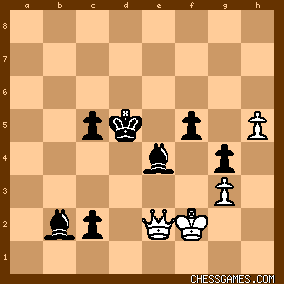
click for larger viewAnd this position is a win for Black in no more than 14 moves at d=26 despite Critter's original [+0.46] evaluation since the front c-pawn queens. What about the possible deviations I thought of (and I'm sure that many of you can think of others)? (1) 34...Bxe2+ 35.Ke1[] Bd3
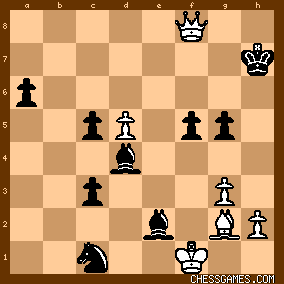
click for larger viewUnusual as it may seem, the line starting with 34...Bxe2+ apparently leads to an inferior position for Black, in spite of the immediate rook capture.
[+4.69]: 36.Qf7+ Bg7 37.Qh5+ Bh6 38.g4 Nb3 39.gxf5 c2 40.Qg6+ Kh8 41.Qxh6+ Kg8 42.Qxg5+ Kf7 43.Qg6+ Kf8 44.Qf6+ Ke8 45.Qe5+ Kd7 46.Qg7+ Kd6 47.Qg6+ Ke5 48.Qg3+ Kf6 49.Qh4+ Kf7 50.Qh5+ Kf8 51.Qh6+ Ke8 52.Qe6+ Kd8 53.Qd6+ Kc8 54.Qc6+ Kd8 55.Qa8+ Kd7 56.Qb7+ Ke8 57.Qc8+ Kf7 58.Qe6+ Kf8 59.Qd6+ Kf7 60.Qd7+ Kf8 61.Qc8+ Kf7 (2) 38.Bxe2
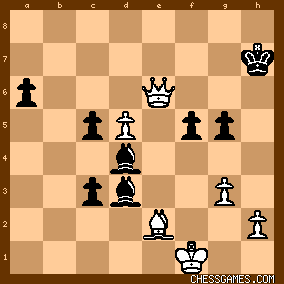
click for larger viewAt d=29 Critter evaluates this line as a draw by repetition, [0.00], given that Black's front c-pawn is about to queen after 38. ... c2 39.Qf7+ Bg7 40.Qh5+ Bh6 41.Bxd3 c1Q+ 42.Kf2 Qb2+ 43.Kf3 Qf6 44.Qe8 g4+ 45.Kg2 Qb2+ 46.Be2 a5 47.Qf7+ Kh8 48.Qe8+ Kg7 49.Qd7+ Kf6 50.Qe6+ Kg7 51.Qd7+ (etc.)
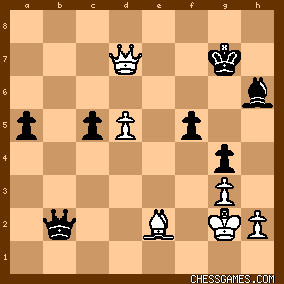
click for larger view |
|
Apr-10-13
 | | AylerKupp: Computer Evaluations (continued) (Part 3 of 4)
(3) 50...Bd4+
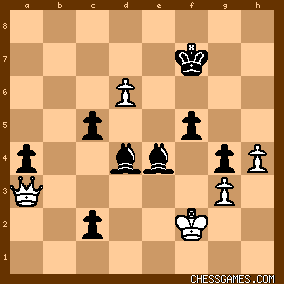
click for larger viewAfter 50...Bd4+ it's over. At d=28 with every pawn directly or indirectly protected and the 2 bishops sweeping the board the only move that Critter finds that avoids mate is 51.Ke2, and I suspect that it would find a mate if I had let it run longer. I'm showing it almost in its entirely since it is actually fun line requiring precise calculation where Black barely escapes but in the end it is evaluated at [-20.66] after 51.Ke2 f4 52.Qa2+ Kf6 53.d7 f3+ 54.Kd2 Be3+ (in the nick of time!) 55.Kxe3 c1Q+ 56.Kxe4 Qe1+ 57.Kd3 Qd1+ 58.Kc4 Qxd7 59.Qa1+ (maybe a mistake but what else does White have?) 59...Qd4+ 60.Qxd4+ cxd4 61.h5 (never give up!) 61...f2 62.h6 f1Q+ and that's enough to show that mate is inevitable, although the line continues showing Critter greedily getting a second queen.
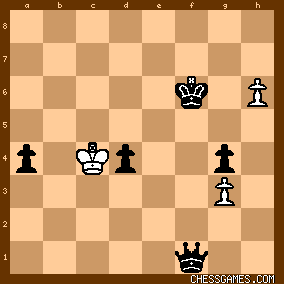
click for larger viewImagine the impossibility of having to calculate this precise sequence way back on move 31! (4) 51.Qxc5
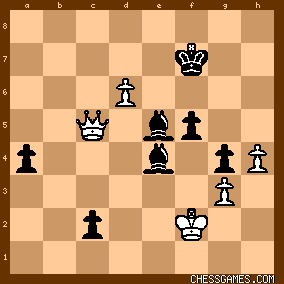
click for larger viewIf instead of the, frankly, obvious 50...Bd4+ Black plays 50...Be5 as in Critter's original line, then if also instead of 51.d7 as in Critter's original line the equally obvious 51.Qxc5 is played, then White salvages the draw since (a) both of Black's pawns are at least temporarily prevented from advancing and (b) White's d-pawn is also threatening to queen. At d=29 Black's best is to sac one of his bishops to allow his c-pawn to queen but then either White or Black has a draw by repetition via either: (a) 51...Bxd6 52.Qxd6 c1Q 53.Qd7+ Kf6 54.Qd6+ Kg7 55.Qe7+ Kh6 56.Qe6+ (56.Qf6+ is even more obvious) 56...Kh5 57.Qe8+ (or 57.Qf7+) 57...Kh6 58.Qe6+ etc.
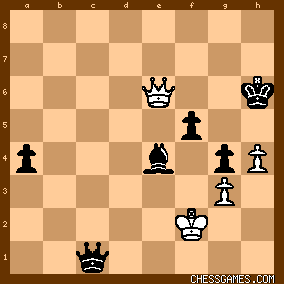
click for larger view(b) 51...Ke6 52.h5 Bd4+ (White also has a draw by repetition after the more obvious 52...Bxd6 starting with either 53.Qc4+ or 53.Qc8+) 53.Qxd4 c1Q 54.d7 Qc2+ 55.Ke3 Qb3+ 56.Kd2 Qa2+ etc.

click for larger view |
|
Apr-10-13
 | | AylerKupp: Conclusions (Part 4 of 4)
So probably the agreed upon draw at move 31 was the correct result. After all, even Critter has problems evaluating the final game position and makes several mistakes towards the end of its analysis. I think these last two lines indicate how difficult it is for even a computer to find the proper continuation(s) starting from move 31. It illustrates the problem with long computer lines and why forward sliding is essential. Even at the reasonably thorough d=30, by the time that move 50 is reached 20 moves into that line (when Black seems to have a forced win) and move 51 is reached (when White seems to have a forced draw), Critter is effectively operating with a search depth = 10. And even with iterative deepening quiescent search, and tablebase support (yes, Critter reached 5-piece tablebase positions even from the initial position), that is insufficient depth to reach an accurate conclusion in the types of positions reached in this game. |
|
Apr-10-13
 | | AylerKupp: <ughaibu> is right, Savon vs Tal, 1970 is the complete game. In case anyone is interested, I did a computer analysis of the final position as well as Tal's suggestion of 31.Rxc3!? and posted it there. I also agree with <lentin's> suggestion of likely time trouble; who wouldn't get into time trouble in a game like this one? |
|
Apr-10-13
 | | perfidious: On the basis of this information, I am submitting a slip to delete this game. |
|
Apr-10-13
 | | perfidious: This game is reminiscent of some early Tal slugfests, during which one asks oneself, 'Where did he come up with #(%! like that?' It certainly merits <AylerKupp>'s description as being 'insane'. |
|
| Apr-10-13 | | RookFile: Good for Tal for pulling out a draw. |
|
| Apr-10-13 | | RookFile: Some players didn't know when it was time to push the "random" button, and ended up going tamely into the night. Tal didn't have that problem. |
|
| Apr-21-15 | | Zugzwangovich: After 31.fg5, isn't the point simply that Tal has a perp after 31...Bd4 32.Kh1 Nf2? This is the line given in the Hilary Thomas collection "Complete Games Of Mikhail Tal 1967-73" |
|
| Apr-24-15 | | zanzibar: <Perfidious> I'm glad you didn't submit the deletion slip, or if you did, then I'm glad that the game didn't get deleted. This is a good example of the fact that GM's can blunder too. The game comes from <Shahkmatny No 12 Dec 1970 p359> game #20. Indeed it's a draw, as White allows a perpetual. (I haven't had time to promptly play it over though.) Beware, <ChessBase Online> has the game ending after 31.fxg5 with the score 1-0. |
|
| Apr-24-15 | | zanzibar: I should mention that <RUSbase> scores it as a draw. |
|
Apr-25-15
 | | Retireborn: <z> The Chess Assistant collection of Tal games gives a draw after 31.fxg5, however they add [...] which implies some further, unknown moves were played. The game is also in Informator, annotated by Kotov, also ends drawn after 31.fxg5 with the annotation 31...Bd4+ 32.Kh1 Nf2+ =. Houdini thinks White should play 32.Kf1 instead and after 32...Nxc1+ 33.Re2 Nxe2 34.Qa7+! [34.Qb7+ Bg7 is only =] Bg7 35.Bh3! Nf4+ 36.Ke1 Nxh3 37.Qf7 Nxg5 38.Qxf5+ Kg8 39.d6 White still has winning chances with the d-pawn. Brain-bending stuff :) |
|
| May-15-16 | | lazerus: I would like to thank everyone on this page for their analysis. I just came across this game in the The Life and Games of Mikhail Tal and couldn't believe that there was no analysis to explain why the draw was agreed upon.
Truly a crazy game. |
|
| Jun-09-16 | | devere: 31...Bd4+ 32.Kf1 Nxc1+ 33.Re2 Nxe2 34.Qa7+ Bg7 35.Bh3 Nd4+! 36.Kf2 c2 37.Qxc5 Bd3 38.d6 hxg5 39.d7 Bf6 40.Qc8 Ne6 41.g4 Be7 42.Qc3 Bc5+ 43.Kg3 Be3 44.Qxd3 c1=Q 45.Qxf5+ Kg7 46.Qxe6 Bf4+ 47.Kf2 Qd2+ draw It seems like it was worth playing out, but maybe there was time pressure. |
|
| Jun-09-16 | | kevin86: Black can now force a perpetual, true? |
|
Jun-09-16
 | | offramp: This game must have been chosen as a tribute to Sanders-Clinton. Everyone knows the result but it's wrong. |
|
| Jun-09-16 | | Nova: What a game! It would have been impressive if Tal declined the draw and "went for the win" in some of the lines <AylerKupp> graciously provided. Who says chess is boring? |
|
| Jun-09-16 | | ajile: Wild game and I have no clue how/why the players got into these positions. Too bad Gashimov is gone since hardly anyone else at top levels plays the Benoni anymore. : / |
|





